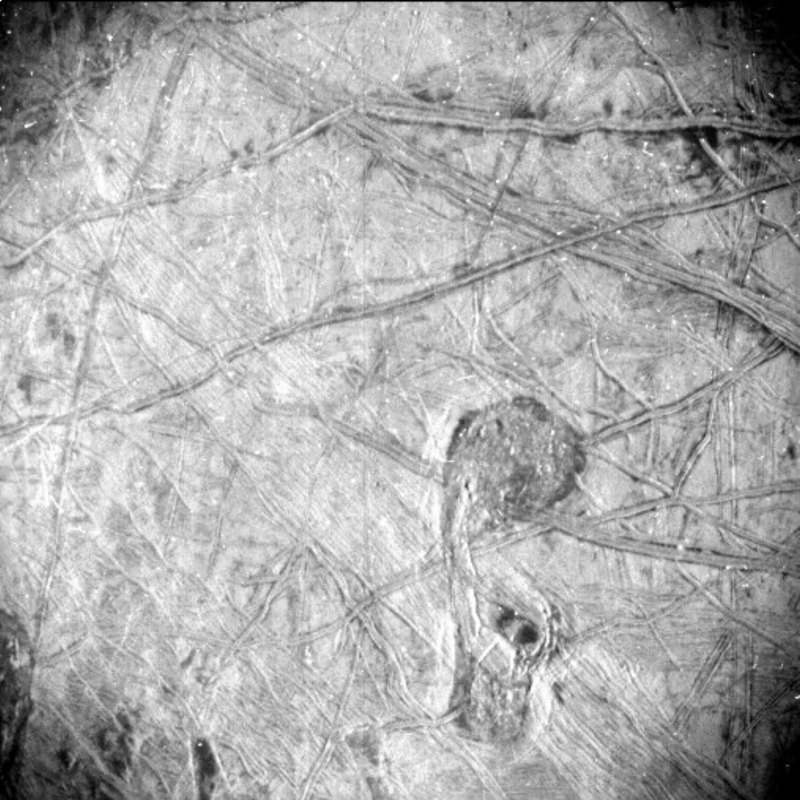
NASA released this new image of Jupiter’s moon Europa on October 5, 2022. It is, significantly, the first close-up in over two decades of this moon, which is thought to have a liquid ocean beneath its icy crust. NASA’s Juno mission captured the image on September 29, 2022, while making a close flyby over the moon. The spacecraft passed only 256 miles (about 400 km) above Europa. And – although it caught only a portion of Europa’s crust – it is, in fact, the clearest image of Europa ever obtained. NASA said:
The image covers about 93 miles (150 km) by 125 miles (200 km) of Europa’s surface, revealing a region crisscrossed with a network of fine grooves and double ridges (pairs of long parallel lines indicating elevated features in the ice). Near the upper right of the image, as well as just to the right and below center, are dark stains possibly linked to something from below erupting onto the surface. Below center and to the right is a surface feature that recalls a musical quarter note, measuring 42 miles (67 km) north-south by 23 miles (37 km) east-west. The white dots in the image are signatures of penetrating high-energy particles from the severe radiation environment around the moon.
Juno flyby of Europa on September 29, 2022
Also, here are some earlier images of Juno’s flyby of Europa. Enjoy these views of this fascinating ocean world.
Early this morning, @NASAJuno flew by Europa, returning our first closeup view since the Galileo spacecraft in 2001. Europa, with its ocean under its icy surface, is the target of @EuropaClipper, which will arrive at the beginning of the next decade to explore. Enjoy the preview! pic.twitter.com/UmeMkq6uKg
— Ted Stryk (@tsplanets) September 29, 2022
This is the surface of Jupiter’s moon Europa, as seen – today – by our #JunoMission spacecraft from a distance of about 219 miles (352 kilometers). Click to see the full view! It shows a region near the moon’s equator called Annwn Regio. Learn more: https://t.co/0v96Hbw04U pic.twitter.com/OZhO5B4GW4
— NASA Solar System (@NASASolarSystem) September 29, 2022
The JunoCam images of Europa from this morning's flyby are here! Here's my attempt at a quick process of one of them. What a view! pic.twitter.com/NpPfBYAAm5
— Will Gater (@willgater) September 29, 2022
The Juno flyby of Europa
Juno came closest to Europa at 2:36 a.m. PDT (5:36 a.m. EDT) on September 29, 2022. Incredibly, the spacecraft came within 334 miles (538 km), capturing never-before-seen images of various portions of the moon’s surface. In addition, scientists also collected data on the moon’s interior, surface composition and ionosphere. Plus, it recorded Europa’s interaction with Jupiter’s magnetosphere, all of which will be useful in the upcoming Europa Clipper mission, set to launch in 2024.
Juno Principal Investigator Scott Bolton of the Southwest Research Institute (SwRI) said:
Europa is such an intriguing Jovian moon, it is the focus of its own future NASA mission. We’re happy to provide data that may help the Europa Clipper team with mission planning, as well as provide new scientific insights into this icy world.
Jupiter’s moon Europa
Europa is, notably, one of the four largest moons of Jupiter. In general, these moons are known as the Galilean moons, and Europa is the second closest to Jupiter and the smallest of the four. Even so, Europa is still 1,940 miles (3,130 km) in diameter, making it about 90% as large as our own moon.
Furthermore, Europa has a surface of water ice, but, scientists believe, a liquid or slushy ocean lies beneath.
Indeed, this possible salty ocean could be a habitat for life.
In the meantime, you can keep track of where Juno is with NASA’s interactive Eyes on the Solar System web page.

Bottom line: Images – including one released October 5, 2022 – from the September 29 Juno flyby of Europa, one of the moons of Jupiter.











